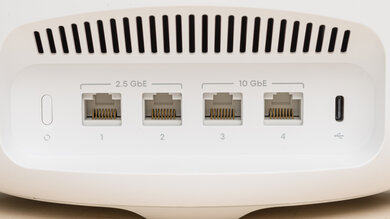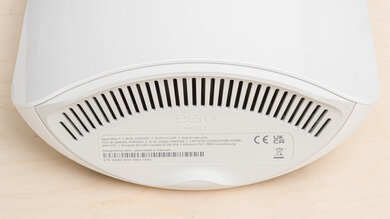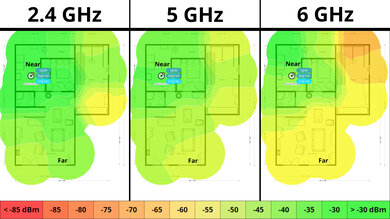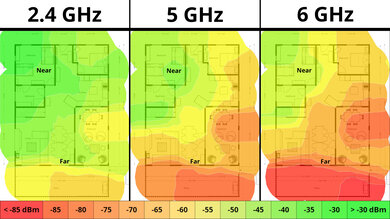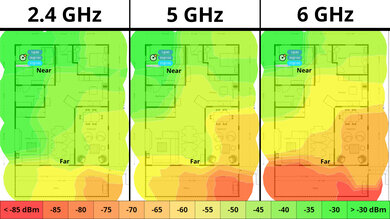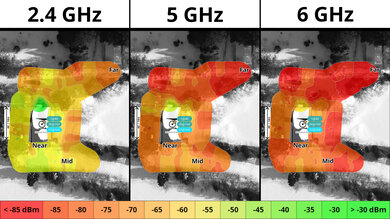The eero Max 7 is eero's flagship tri-band Wi-Fi 7 router with 2.4GHz, 5GHz, and 6GHz bands. It's designed to work in a mesh system with other access points and is available as a standalone router or in various multi-packs. Like eero's other routers, it has a sleek design with a glossy white finish, but it's considerably larger. The larger body holds more networking ports, two rated for 2.5Gbps and two rated for 10Gbps. It features a built-in smart-home hub that supports Thread, Matter, and Zigbee devices. You manage the router through eero's mobile app, where you can configure basic settings. The app has a paid subscription tier that allows you to access additional features like ad blocking, content filters, and a VPN.
Our Verdict
The eero Max 7 is a fantastic router if you live in an apartment, condo, or single-story home. It's fast enough to saturate a multi-gigabit internet connection, and you'll have no problems with downloading very large files quickly or multiple users streaming 4k video content simultaneously. It also has a sleek design that won't be unsightly in your living space, though it's bigger than other eero routers. It has a built-in smart home hub, but many useful and expected features like parental controls and app blocking are only accessible if you pay for an eero Plus subscription.
- Sleek design.
- Outstanding range performance.
- Built-in smart home integration.
- Ample multi-gigabit networking ports.
- Exceptional top speeds.
- Have to pay an additional subscription fee for advanced features.
The eero Max 7 is a fantastic router if you live in a multi-level home. Its network coverage is good enough to provide a fast and stable connection throughout your home that's suitable for even the most bandwidth-intensive tasks. You can also easily add access points for better signal strength throughout your home and backyard. It has a convenient app, but useful features like parental control are only accessible if you pay for an eero Plus subscription.
- Sleek design.
- Outstanding range performance.
- Can add additional mesh access points to improve range.
- Built-in smart home integration.
- Ample multi-gigabit networking ports.
- Exceptional top speeds.
- Have to pay an additional subscription fee for advanced features.
The eero Max 7 delivers exceptionally fast speeds suitable for a multi-gigabit internet connection. It also supports DFS (Dynamic Frequency Selection), so it can use less congested DFS-only channels to give you better speeds in noisy wireless environments.
- Exceptional top speeds.
The eero Max 7 has superb range performance. Since it's a mesh router, satellite access points help it maintain consistent average speeds over long distances, making it suitable for high-bandwidth uses and high-speed downloads over a wide area.
- Outstanding range performance.
- Can add additional mesh access points to improve range.
Changelog
- Updated Dec 16, 2025: We've added an MLO Implementation test for Test Bench 0.8.2! Read the changelog for more details.
-
Updated Jun 10, 2025:
We've added a link to the newly reviewed UniFi Dream Router 7 in the Network Ports section of this review.
- Updated May 01, 2025: We've converted this review to Test Bench 0.8.1. This includes a new test result for our Test Configuration box.
-
Updated Oct 30, 2024:
We've added links to the newly-reviewed TP-Link Deco BE63 and TP-Link Deco BE65 Pro in the Dimensions section of the review.
Check Price
Differences Between Sizes And Variants
The eero Max 7 is available on its own or in a two or three-pack. We bought and tested a two-pack. Here's a photo of our unit's label.
Popular Router Comparisons
The eero Max 7 is eero's flagship Wi-Fi 7 router. It shares many features with other routers from eero; it supports mesh networking with additional access points and compatibility with Zigbee smart home devices. eero offers an "eero Plus" membership that allows you to access advanced settings and additional features like ad blocking, content filters, and VPN access.
You manage the router and change its settings through eero's app, which, while convenient and easy to use, doesn't offer much flexibility in terms of advanced settings and network controls. eero also doesn't have a web interface at the time of writing either, which most other routers in this category offer.
This router is a superb Wi-Fi 7 option that stands out for its incredible top speeds and outstanding range performance, outperforming the standalone ASUS RT-BE96U.
If you're looking for more options, check out our recommendations for the best Wi-Fi routers, the best mesh Wi-Fi systems, and the best routers for large homes.
The eero Max 7 is a better router than the eero Pro 7. It delivers significantly faster top speeds, better range, and has a better port selection with two 10GbE and two 2.5GbE ports, while the Pro 7 only has two 5GbE ports. That said, the Pro 7 is smaller than the Max 7, so it doesn't stick out as much in your living space. Other than the performance and size differences, the two routers offer nearly identical functionality.
The eero Max 7 and the TP-Link Deco BE65 Pro are Wi-Fi 7 mesh routers. The eero has significantly better range and speed than the TP-Link, and it's bigger.
The eero Max 7 and the TP-Link Deco BE63 are Wi-Fi 7 mesh routers. The eero has significantly better range and speed performance than the TP-Link, but the eero has a larger footprint and occupies a much more premium price point.
The TP-Link BE900 and the eero Max 7 are Wi-Fi 7 routers. The eero is a tri-band router designed to be used in a mesh system, while the TP-Link is a quad-band standalone router. The eero delivers higher top speeds and better range than the TP-Link when the former is used in a dual mesh configuration. That said, the TP-Link has better wired networking with more Ethernet ports, and a more configurable software experience with more features than the eero.
Test Results

If you're looking for a smaller Wi-Fi 7 mesh router, check out the TP-Link Deco BE63 or TP-Link Deco BE65 Pro.
This router's networking ports automatically detect whether you use a WAN or LAN connection.
If you're looking for a router with a 10Gbps SFP+ port, check out the UniFi Dream Router 7.
While this router has a USB-C port, it's only for power and doesn't support data transfer.
We tested this router in dual mesh mode. Note that the router was initially only broadcasting on 160MHz channels on the 6GHz band instead of on the 320MHz channels, resulting in much slower speeds. The router only switched to the faster 320MHz channels after a few hours. Let us know in the comments if you experience similar behavior.
We tested this router in dual mesh mode. When connected to the satellite, there's a speed penalty on the 6GHz band, but this is expected. A satellite unit is likely unnecessary if you have a smaller home without dead zones or obstacles like concrete walls.
Wi-Fi 7 has faster speeds, lower latency, and supports more simultaneous connections than previous generations of Wi-Fi. However, you'll need devices supporting Wi-Fi 7 to benefit from these features.


